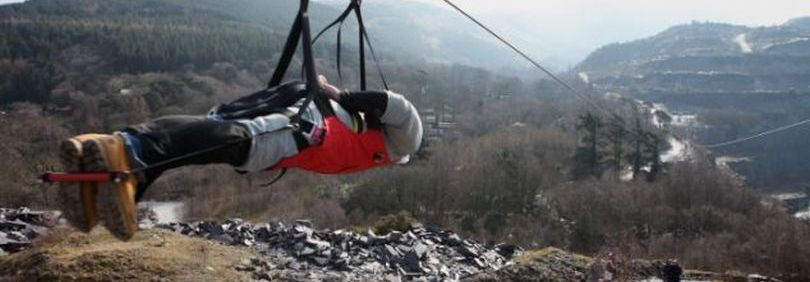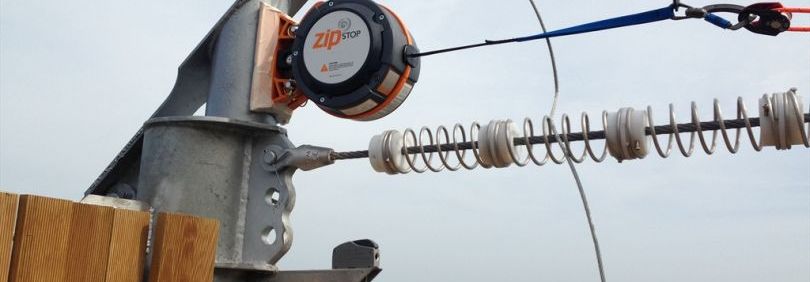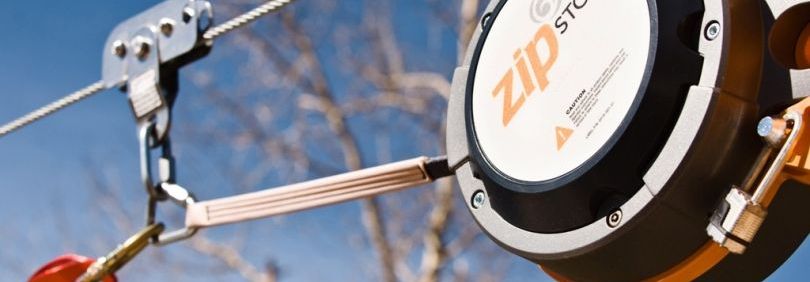There are two main categories of zip line brakes: active and passive. The type of brake you choose will dramatically affect your business’s risk management and the life span of your zip line materials. Active zip line brakes depend on the rider to initiate the braking process. Passive zip line brakes automatically activate without the rider or a guide doing anything. While active brakes may give riders more participation in the experience, it introduces additional risk.

Active Braking
The most common types of active zip line brakes are leather gloves and brake pads. Participants must intentionally press a glove or brake pad against a zip line cable in order to slow down. Active brakes substantially increase the risk of injury to participants for several reasons. It is easy for participants to get lost in the excitement and adrenaline of the moment and forget braking instructions. Moreover, active brakes force the rider to put their hands and limbs close to fast moving zip line components. Proximity alone increases the risk that a participant will either get a friction burn on an exposed piece of skin, or mangle their hand by getting it caught in the rider trolley. These injuries are among the least severe injuries possible when dealing with active brakes. The worst possible injuries associated with active brakes are life-threatening.
When zip line operations use active braking methods, inexperienced and overwhelmed riders have the highest risk for life-threatening injuries. Some participants might become overwhelmed because they are not ready for the extreme heights and speeds of zip lining. In the worst case scenario, overwhelmed riders faint. It doesn’t need to be said that unconscious participants cannot brake themselves.
There is still an increased risk to riders even if the participant does not pass out. If a rider loses composure or becomes distracted then there is a chance that they might brake too late or fail to brake at all. There are a wide variety of people that are prone to losing composure or becoming distracted. Young participants and children are a prime example of this user group, but this could happen to people of any age. Increased injury risk is only one problem with active braking.
What happens if the riders choose to brake too early or too aggressively? The answer is that they fail to make it to the platform and the entire group has to wait for them to haul themselves to the end of the line. Premature braking is a detriment to the efficiency of your zip line operation. The more happy customers you can get through your zip line course, the higher your potential revenue. Even 30 seconds of downtime per customer can severely reduce the efficiency of your zip line facility. Active braking does not provide an immense amount of control over the throughput of your zip line. If you’re interested in increasing the efficiency of your zip line operation you should read this article about Head Rush Technologies’ solution to the problem.
Active brakes have one last misgiving. They increase wear and tear on crucial zip line components. Active brakes rely on friction, and there is no way to get around it. Friction is the fundamental component that makes active brakes work. This very friction is what increases the amount of wear on your zip line cable and the active brake itself. Increased wear means that you’re going to have to replace your zip line cable more frequently in addition to continuously replacing gloves and brake pads. It also means more downtime while your cable and other components are being replaced. At first active braking might look like it costs less, but it will end up costing you more in the long run.
The additional costs of active braking include increased injury risk, decreased throughput and increased material replacement costs. The viability of your business might hinge on your choice to use active braking methods. The main issue is injury risk. If a customer gets hurt on your course you might be forced to pay a significant amount of money as a legal remedy. Even if there is zero financial burden as a result of an injury or fatality, your business reputation could still be at risk.
The safety reputation of your operation is crucial. In this day and age, potential customers can easily research the history of a company with the help of the internet. A poor safety reputation can be the difference between having the best zip line in town and having to file for bankruptcy. Don’t risk your business’s future.

Passive Braking
There are many different types of passive braking. The most commonly used passive brakes are: magnetic brakes, gravity brakes, and spring brakes. Passive brakes take the responsibility of braking away from the rider. Passive braking methods will activate even if the participant suffers a breakdown mid zip and is unable to stop themselves. This aspect of risk management alone makes passive brakes superior to active brakes. There are many zip line brakes that fall into the passive brake category. How do different passive zip line brakes compare?
Magnetic Brakes
The zipSTOP Zip Line Brake is alone in its own tier of passive zip line brakes. The zipSTOP is the only magnetic zip line brake on the market. The zipSTOP uses eddy current magnetic braking technology to eliminate the need for sacrificial braking components. That means there are no brake pads or any internal braking components whatsoever that rely on friction. The result is that the zipSTOP has less maintenance because there are no components of the braking core designed to wear out or fail. The magnetic technology does more than decrease maintenance and increase product longevity.
The eddy current magnetic braking technology in the zipSTOP provides consistently smooth braking experiences for participants by self-regulating braking resistance for each individual. A 33 lb kid and a 330 lb football player will both experience the same comfortable deceleration. Other zip line brakes do not have the benefit of self-regulating braking resistance. Without the automatic regulation of braking resistance found in the zipSTOP, the 33 lb kid will have a harsher jolt on impact compared to heavier riders. Magnetic braking allows zip line operations to provide the same high quality zip line experience to every participant regardless of weight. You can click here if you want to learn more about the science behind eddy current magnetic braking.
In addition to the benefits of magnetic braking, the zipSTOP is incredible for improving throughput. The zipSTOP automatically resets after every use. Automatic reset means less downtime waiting for the guide to reset the brake for the next rider. Automatic reset also eliminates the chance that the guide will forget to reset the brake at all. The throughput efficiency of the zipSTOP is enhanced when it is combined with other Head Rush zip lines accessories. The brake trolley in the zipSTOP zip line brake system can be outfitted with a catch mechanism that pairs with the Head Rush Impact Trolley to eliminate rider rollback. The Impact Trolley and the brake trolley latch together during the braking process to make rider retrieval quick and painless. Less downtime between riders allows you to get more customers through your course every day and increases your total potential revenue. If you’re interested in increasing throughput on your zip line, you should take a look at this one easy trick to double the efficiency of your zip line.
The decreased maintenance, smooth braking experience and the increased throughput of the zipSTOP make it a truly unique zip line brake. Currently, at the time this article is being written, there is no zip line brake in the same league as the zipSTOP. You won’t be able to find a similar zip line brake anywhere that provides the same feature and benefits. The zipSTOP is the premiere zip line brake of choice for zip line operators.

Gravity Brakes
A gravity brake is essentially the absence of a zip line brake. Gravity brakes are zip lines designed so that the rider will not be able to reach the end. Usually, zip lines that use gravity brakes have a significant amount of slack so the end of the cable is uphill. The uphill portion of the zip line slows the rider until they change directions. Then they boomerang back and forth until they come to a stop at the sagging low point in the line.
Most zip lines that implement gravity brakes have to use a shallow slope to make it work. For that reason, gravity brake zip lines are usually slower. High tension, high velocity zip lines are out of the question when using a gravity brake. Gravity brakes are less common on longer zip lines for the same reason. The longer your zip line is the more time there is for participants to gain speed. The faster your rider is going the more cable you have to dedicate to the uphill portion of the line. If your zip line course is oriented to providing long length or high speed adventures you should reconsider installing a gravity brake.
Another drawback of gravity brakes is their low throughput. It takes time for a participant to ricochet back and forth enough to come to a stop. This rolling back and forth to slow down is the least appealing part of the zip line. Slowing down is the most boring part. Especially when it’s prolonged into a lethargic swinging motion. The time it takes waiting for a gravity brake to slow a participant doesn’t add value for the customer. That time would be better spent sending another rider down the line and would allow the whole group to spend less time waiting and more time zipping.
The most frustrating shortcoming of gravity brakes for zip line owners is probably the inefficient use of space. Most zip line owners want to use as much of their terrain as possible in their zip line course. Gravity brakes require that a portion of the cable is dedicated to braking, which means that a portion of the cable and a portion of your facility is effectively being unused. Think of all of the scenic views and fun that your customers are missing out on because the last segment of your cable is intentionally designed to never be used.
All of these deficiencies occur before you even attempt to have participants stop at a platform that is not at the low point of the line. You take on another set of problems when you try to make participants time a landing on a platform. Every rider is different and it is difficult to predict exactly where the riders will end up. Lightweight riders will tend to stop short of the platform. Heavier riders will approach the platform too quickly and are at a greater risk of injuring themselves or the zip line staff. Depending on the situation you could be risking your efficiency or even worse a lawsuit.
Spring Brakes
Spring brakes are large metal coils that compress upon impact. The compression of the spring absorbs the momentum of the rider and brings them to a stop. Conventional spring brakes decompress and then push the rider back out in the direction they came from. This is obviously an issue for zip line throughput. The time that it takes riders to stop rebounding is precious time lost. Every second that a customer spends bouncing around at the end of the line is a second that you could be using to get another customer through the course. These seemingly small inefficiencies quickly add up and make a significant impact on throughput. Throughput is critical for customer satisfaction and your operation’s efficiency.
There are a lot of factors that cumulate to affect your final speed at the end of the zip line before you start braking. Rider weight, wind speed and cable conditions are just a few of those factors. Spring brakes are a one size fits all solution where one size isn’t really optimal. Different weight riders will have different braking experiences with spring brakes. Heavier riders are going to cause more spring compression and will rebound further. Lightweight riders will compress the spring less and will experience a more abrupt stop than heavier riders. This wide range of possible outcomes is present even before taking into account any other factors.
Weather conditions and other influences further increase the range of potential landing speeds. Headwinds will slow riders down and tailwinds will speed riders up. If the cable is wet from rain or morning dew then riders will arrive faster than if they were on a dry cable. Zip line spring brakes can’t and won’t adjust braking resistance for all of these different scenarios. Inability to adjust braking resistance eliminates your ability to provide a consistently smooth braking experience. Some of your riders will probably brake comfortably, but the majority of participants will experience a jarring brake. Don’t you want to prevent your riders from feeling a harsh jolt at the end of your zip line?
For the reasons listed above, spring brakes aren’t an optimal as primary brakes for zip lines. On the other hand, spring brakes are great when used as emergency arrest devices. ACCT standards require the use of an emergency arrest device on all zip lines in excess of 6 mph (10 kph). Emergency arrest devices are back-up zip line brakes that are completely separate from the primary brake and require no action by the participant to engage. In other words, emergency arrest devices are passive brakes independent of the primary brake. Emergency arrest devices are intended to prevent serious injury or death as a result of user error or equipment failure. Emergency arrest devices are not intended to be comfortable or have high throughput. That is why you should consider using spring brakes as a backup.
Conclusion
Passive zip line brakes are superior to active zip line brakes. The main benefit of passive zip line brakes is that they eliminate the risk that participants will hurt themselves by improperly braking. Among passive zip line brakes, the zipSTOP stands alone as the best brake in the industry. The zipSTOP is superior due to its ability to provide a comfortable braking experience, automatically reset, increase throughput, and automatically regulate braking resistance. Spring brakes are a great supplement to the zipSTOP when used as an emergency arrest device, but fall short when used as a primary brake. The zipSTOP provides everything you need in a zip line brake.

Planning a zipline installation? Need expert advice on zipline design?
Get started Today
Additional expert Information regarding Zipline technology
Interested to read more about Zipline technology and expert opinions?
- The Power of Zip Line Simulation Software
- Bi-Directional Zip Line Technology
- Zip Line Design: Components for a Complete System
- How a Zipline Feasibility Study Guarantees Success
- MAG Brake Trolley, the Magnetic Self-braking Zipline pulley
- Professional Zipline Engineering & Design services
- How to Launch a Zip Line Company
- The Science of Zipline Design and Engineering
- Zipline Mistakes You Don’t Know You’re Making
- Key elements: Zipline Design and Engineering
- Thinking of investing and operating a Zipline?
- Zipline Emergency Arrest Devices (EADs)
- The ZipCoaster - Fly through the air, dipping and twisting
- Pros and Cons of Different Zip Line Brakes
- Expert Tips for Zip Line Brake Installations
- Thinking of investing and operating a Zipline?
- Ingenious inventions. The curvy zip line












